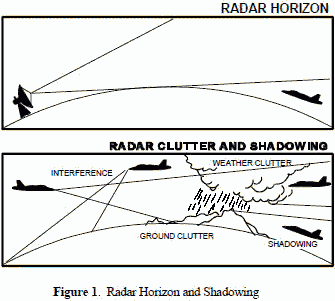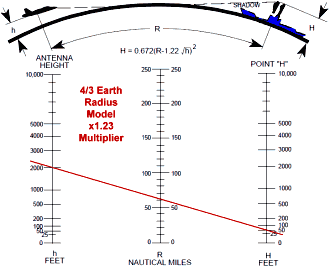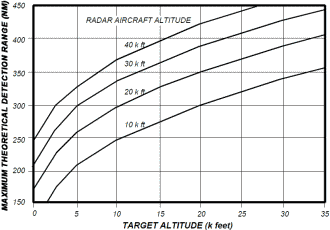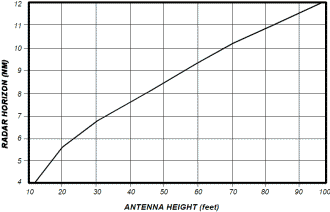Electronic Warfare and Radar Systems Engineering Handbook |
|
RADAR HORIZON / LINE OF SIGHT There are limits to the reach of radar signals. At the frequencies normally used for radar, radio waves usually travel in a straight line. The waves may be obstructed by weather or shadowing, and interference may come from other aircraft or from reflections from ground objects (Figure 1). As also shown in Figure 1, an aircraft may not be detected because it is below the radar line which is tangent to the earths surface. Some rules of thumb are:
Range (to horizon):
Range (beyond horizon / over earth curvature):
For a true line of sight, such as used for optical search and rescue, the constant in the equations changes from 1.23 to 1.06. A nomograph for determining maximum target range is depicted in Figure 2. Although an aircraft is shown to the left, it could just as well be a ship, with radars on a mast of height "h". Any target of height (or altitude) "H" is depicted on the right side. See also Section 5-1 on ducting and refraction, which may increase range beyond these distances. This data was expanded in Figure 3 to consider the maximum range one aircraft can detect another aircraft using:
It can be used for surface targets if target = 0. It should be noted that most aircraft radars are limited in power output, and would not detect small or surface objects at the listed ranges. Other general rules of thumb for surface "targets/radars" are: For Visual SAR:
For ESM:
Figure 4 depicts the maximum range that a ship height antenna can detect a zero height object (i.e. rowboat etc). In this case "H" = 0, and the general equation becomes:
Where hr is the height of the radar in feet. Table of Contents for Electronics Warfare and Radar Engineering Handbook Introduction | Abbreviations | Decibel | Duty Cycle | Doppler Shift | Radar Horizon / Line of Sight | Propagation Time / Resolution | Modulation | Transforms / Wavelets | Antenna Introduction / Basics | Polarization | Radiation Patterns | Frequency / Phase Effects of Antennas | Antenna Near Field | Radiation Hazards | Power Density | One-Way Radar Equation / RF Propagation | Two-Way Radar Equation (Monostatic) | Alternate Two-Way Radar Equation | Two-Way Radar Equation (Bistatic) | Jamming to Signal (J/S) Ratio - Constant Power [Saturated] Jamming | Support Jamming | Radar Cross Section (RCS) | Emission Control (EMCON) | RF Atmospheric Absorption / Ducting | Receiver Sensitivity / Noise | Receiver Types and Characteristics | General Radar Display Types | IFF - Identification - Friend or Foe | Receiver Tests | Signal Sorting Methods and Direction Finding | Voltage Standing Wave Ratio (VSWR) / Reflection Coefficient / Return Loss / Mismatch Loss | Microwave Coaxial Connectors | Power Dividers/Combiner and Directional Couplers | Attenuators / Filters / DC Blocks | Terminations / Dummy Loads | Circulators and Diplexers | Mixers and Frequency Discriminators | Detectors | Microwave Measurements | Microwave Waveguides and Coaxial Cable | Electro-Optics | Laser Safety | Mach Number and Airspeed vs. Altitude Mach Number | EMP/ Aircraft Dimensions | Data Busses | RS-232 Interface | RS-422 Balanced Voltage Interface | RS-485 Interface | IEEE-488 Interface Bus (HP-IB/GP-IB) | MIL-STD-1553 & 1773 Data Bus | This HTML version may be printed but not reproduced on websites.
Related Pages on RF Cafe - Introduction to Radar (Air University) - Radar Equation, 2-Way (another) - Radar Techniques - Primer (1945 QST) - RF Cafe Quiz #7 - Radar Principles - EW/Radar Handbook - Doppler Shift - Identification Friend or Foe (IFF) |









